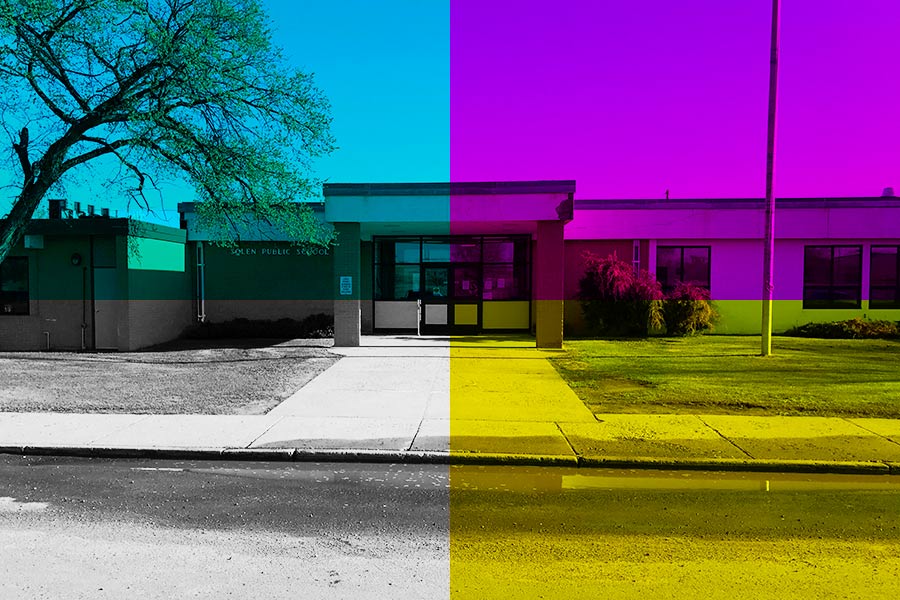A North Dakota High School Forges a Future
Solen High School is on the northern edge of the Standing Rock reservation, about a twenty minute drive west of Sacred Stone Camp, the epicenter of the recent resistance effort against the Dakota Access Pipeline.
While the protests at Standing Rock were drawing attention and thousands of participants to a part of the country often peripheral in the national consciousness, the teachers at Solen High had to balance their educational mission with the disruption created in their students’ lives.
In the early days of the protests, Rachael Southam challenged her English and social studies students to research and debate the conflict. Those conversations often turned contentious: some students’ families stood to benefit financially from proposed easements on their land while others were concerned about the potential environmental damage and violation of treaty rights.
But as the protests persisted, Southam says that they became a distraction as students began missing school to attend.
“For many of my kids,” Southam adds, “that’s all they wanted to do. They’d go home after school, and they’d be out at the camps, and then they’d be sleeping in class all day. I had some kids who missed weeks of school because they were out at the camp.”
In addition to some absenteeism on account of the protests, Solen also had a brief influx of students. Principal Jeff Brandt was keenly aware of the impact of this population spike on the school.
“We weren’t prepared to have fifteen more kids,” Brandt says. Solen is a small school district, with limited staffing and resources, so a sudden increase in population presents challenges in the classroom. But, Brandt explains, the teachers’ attitude was, “Whatever is necessary for student success, we will do’.”
This flexibility and prioritization of student needs are two hallmarks of Solen, a school that has within the last few years assembled a potently committed team of teachers and administrators set on transforming the school and overcoming challenges that have, historically, hindered its ability to facilitate student success.
Solen is a public school that serves around one-hundred 7th-12th graders, all of whom are Native American. In the past this demographic ratio was far more mixed, with many children from white ranching families attending the school. This shifted in part, however, as a result of the No Child Left Behind Act (NCLB) of 2001.
One of the provisions of NCLB enabled parents to remove children from schools failing to meet for two or more years “Adequate Yearly Progress” testing standards. Because Solen was not advancing sufficiently toward these benchmarks, many of the students whose families could afford to send them elsewhere did.
But, for the Solen students, NCLB created isolation, says Southam. “We continue to have many ranchers that send their kids pretty far. As a parent I can’t blame them, necessarily, because we’ve changed so fast that it’s almost like, ‘Well, we’ll see what happens’.”
Over the past five years, Solen’s reputation has transformed, evinced by a doubling in enrollment during that time. This shift is a result of a change in administration, a Federal School Improvement Grant, and the hiring of teachers hyper-focused on serving students who need a lot of understanding and patience due to the challenges they face on the reservation.
The Standing Rock Sioux Tribe’s 2013-2017 Comprehensive Economic Development Strategy outlinessome of the difficulties faced on the reservation, including job scarcity for a population of which 46% are younger than 24, overcrowding caused by a lack of viable housing, a poor transportation system that makes accessing resources more difficult (hitchhiking is a common way to get around), water quality issues, and a 30-year poverty rate of 42% that brings with it a variety of health challenges, including substance abuse.
“It’s a tough place,” says Mark Holman, a librarian at Sitting Bull College in Fort Yates, and a resident on the reservation for over a decade. “The issues weigh on everything that happens here. People have a lot of loss in their lives. For some people twenty dollars can mean the difference between moving forward or sliding back down the hill.”

Jeff Brandt, who became principal at Solen five years ago after working at the school as a business teacher, is well aware of what his students face. He points out, “Some of our students don’t know where they’re going at night when they leave school, some of them don’t know where their next meal is coming from.”
These challenges are an outgrowth of the history of the reservation itself. The Standing Rock reservation dates from 1889 and its story is one of exploitation of the Hunkpapa, Sihasapa, and Yanktonai Sioux by the United States government. According to anthropologist Timothy Kloberdanz, the reservation was established after 11 million acres of land, pledged to the Sioux by treaty, were taken by the government, leaving the tribes around 2.5 million acres.
The problems faced today by the ancestors of these tribes are a legacy of the early conditions on the reservation. As Kloberdanz explains, “Living conditions…during the 1890s were deplorable. The Standing Rock Sioux had been compelled to make a sudden and difficult transition, one that forced them from a nomadic, buffalo-hunting way of life into a settled, government-run existence. At the same time that the Sioux tried to withstand the physically debilitating forces of disease and malnutrition, the Indians were weakened psychologically and emotionally by missionization and other types of directed culture change.”
Part of this acculturation was accomplished through boarding schools, where, as librarian Mark Holman explains, the idea was to “bring people in, cut their hair, put them in Western clothes, make them speak English. They had grown up speaking Lakota but then were thrust in this English-only environment where everything was foreign.”
Racism was endemic to these boarding schools, whose creators believed that any child’s failure to learn was attributable to the child’s Native American heritage. This traditional view of Native American learners has had lingering effects. Brandt explains that many of Solen’s past teachers and administrators may have had “a perception that teachers can go to the reservation schools and not do anything. You just go there, the kids aren’t going to learn, and that’s it.” Brandt pauses, then continues, “I want to be careful about how I say this, but I think some of the people who were here before had a perception, and it’s a very racist perception, that native kids couldn’t learn. And their expectations of what the kids were going to achieve in class were so low that they basically didn’t have any expectations.”
Lori Hager, an Art and History teacher who has worked at Solen for thirty-four years, says this attitude manifested in classrooms where teachers would show moves for weeks on end. “That should not have been allowed, but it was the path of least resistance.”
Historically, Solen has suffered from high teacher and administrative turnover, attributable in some cases to normal staff shuffling as teachers moved to other schools, but often resulting from difficulties with the students themselves.
Hager recalls many tough times with students, “They test you terribly your first year. And they do it because everybody leaves them—sooner or later everybody leaves them—so they test you to see if you care about them enough to stay. Once they figure out that you’re going to stay, they give you their heart.” Southam also emphasizes the challenges for first-year teachers. She says, “At some point during the first semester there’s going to be tears. You have to grow this weird thick and thin skin. You don’t want to get so thick-skinned that you become insensitive, so you have to think: ‘What is talking here is not this kid. They are angry at something they cannot control in their life.’ If it’s something you really want to do, you’ll adapt.”
Solen’s current teachers are committed. Many live in the Bismark/Mandan area forty-five miles north of the school and commute over an hour and a half every day, often staying late for tutoring or parent-teacher conferences. When Solen was awarded the Federal School Improvement Grant, teachers who weren’t ready to commit to doing what would be necessary to improve the school moved on, leaving those who were prepared to give their all to the students.
Now, the graduation rate, once around 26%, is slowly but steadily increasing. For the first time in the school’s history students are taking dual credit courses. Brandt prioritized the introduction of these classes due to their potential for easing the transition to college, which has traditionally not been easy for Solen’s graduates due to “culture shock” experienced by Native American students who may have spent little time away from the reservation community.
Things at Solen continue to improve, but there’s an awareness on the part of the staff that the fate of the school rests in others’ hands. Because of its small tax base, Solen depends on federal impact aid, state foundation aid, and grants like School Improvement and Rapid Enrollment Grants. Without these resources, it would be difficult for the school to continue on its current path.
At Solen they are also wary of decisions being made in Washington and feel that there is a basic misunderstanding of, or inexperience with, what it really takes to impact students in a difficult school environment.
What most concerns Southam about the current educational shifts is that those in power make far-reaching policy changes without proper knowledge about what the communities, schools, and students are going through. From Southam’s perspective, “You need leadership experience and teaching experience in a public school that helps everybody no matter where they come from. Otherwise, let somebody who has experience make those policy issues.”
Brandt agrees. “From a school choice standpoint, it’s scary for lower-income, more needy students. When I hear that the Secretary of Education wants to do away with public schools—well, I don’t think that’s possible, for one—but that’s a scary proposition when you think about the millions of students that depend and rely on public schools and public school teachers.”
Despite these anxieties, Solen has a lot to be optimistic about. The teachers are committed, scrappy, and the students are beginning to flourish from the focused nourishment and support.
In the view of Lori Hager, the veteran teacher of thirty-four years, “The kids seem happy to be here. There just seems to be a better feeling of camaraderie. Less fighting or arguing with teachers. The kids are taking pride in their learning. When they get improved scores you can see the light in their faces; it’s fun to watch. Seeing that they have pride that they can do that makes me happy.”
Lizz Stearns is a writer and the associate editor of Between Coasts. She resettled recently in Newark, Ohio, after living and teaching literature in Colorado, New York, and Texas. Originally from Lubbock, Texas. She is currently writing grants for non-profits.

